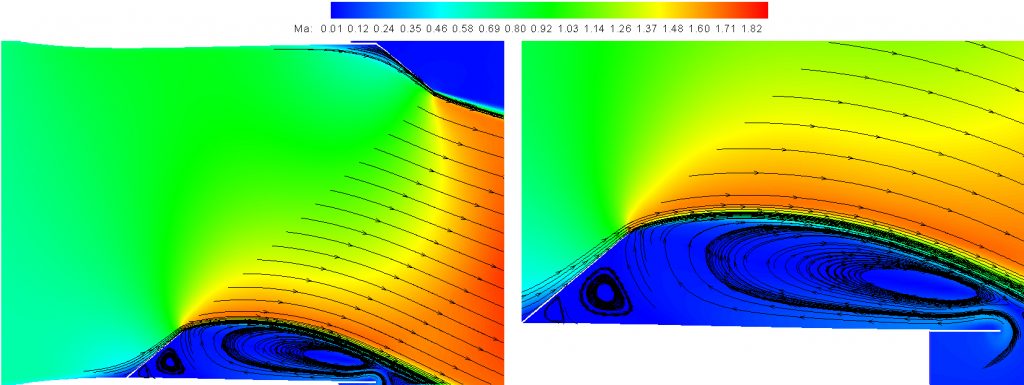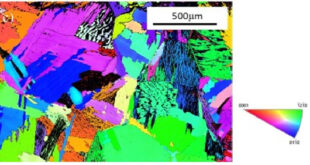Significance
Significant technological innovations have been made in jet engines to achieve outstanding thermal efficiency with increased thrust, enabling aircraft to go greater distances. Researchers have also continued to explore the potential to vector the produced thrust (thrust vector control) to better manipulate the direction of the thrust from its engine in order to control the attitude or exit angular velocity making aircraft more maneuverable. Therefore, they have proposed a number of vector control mechanisms, which are either mechanical or fluidic.
Fluidic vector control mechanisms such as shock vector control, counter-flow, and co-flow have been investigated. All the three methods adopt a secondary flow, but shock vector control adopts a secondary injected flow to generate an oblique shockwave. All the investigations centering on the three methods have reported flow deflections within 30°.
Mechanical thrust control mechanisms, for example, small external and rotatable nozzles, external flaps, and swiveling the nozzle’s diverging section, have been implemented in military jet engines. Depending on the arrangement, these mechanisms can vector an engine’s thrust up to 90°. Some mechanical thrust vector control designs implement a flap system, while others adopt asymmetrically sized flaps for thrust vectoring in the pitch direction.
Carlos Montes and Professor Roger Davis at the University of California Davis explored the vectoring performance of a unique mechanical mechanism implementing a ramp at the nozzle throat along one wall and another at the exit of the opposite wall. They designed the nozzle for air-breathing engines using piecewise quartic splines, isentropic relationships, and published engine data. Their research work is published in the Journal of Engineering for Gas Turbines and Power.
The proposed mechanism used two staggered, adjustable ramps. By comparing the findings of a baseline inviscid numerical simulation without ramps with analytical data, the authors were able to verify the nozzle design. They later evaluated 9 ramp setups under steady-state turbulent viscous conditions implementing two sets of parameters that corresponded to inlet conditions with and without an after burner.
The use of both internal and external ramps reported excellent thrust vector control performance when compared to the performance of purely fluidic thrust vector control mechanisms. Significant flow deflections as high as 21° were realized when the ramp length used was less than the nozzle’s length.
The authors found that the thrust vectoring of the proposed nozzle arrangement increased with increasing angle and ramp length. When the largest ramp angle was used, a maximum flow deflection of about 30° was recorded. While the results recorded fell below the values of other mechanical thrust vector control designs, it was projected that larger ramp angles would have resulted to greater flow deflection angles.
For a given ramp configuration, the mean flow deflection angle would be obtained by numerically integrating the flow angle distribution at the second ramp’s exit plane and weighting the value with the corresponding exit area. The authors recorded an excellent thrust vectoring performance with non-after-burner conditions. At moderate to high angles and ramp lengths, the flow solution residuals modulated suggesting the presence of an unsteady flow.
The thrust vectoring data obtained by Carlos Montes and Roger Davis through the steady-state simulation are promising in the performance potential of the provisionally patented thrust vector control mechanism.

Figure legend: Mach number contour plot for one of our ramp configurations (40 deg, 3.5-in long), but with streamlines added to provide some insight on the recirculating flow downstream of the throat ramp. Additionally, the streamlines in the core flow at the exit provide a visualization of average flow deflection angle (-24.5 deg as reported for this configuration).
Reference
Carlos F. Montes and Roger L. Davis. Two-Dimensional Supersonic Thrust Vectoring Using Staggered Ramps. Journal of Engineering for Gas Turbines and Power August 2017, Vol. 139 / 082605-1.
Go To Journal of Engineering for Gas Turbines and Power
 Advances in Engineering Advances in Engineering features breaking research judged by Advances in Engineering advisory team to be of key importance in the Engineering field. Papers are selected from over 10,000 published each week from most peer reviewed journals.
Advances in Engineering Advances in Engineering features breaking research judged by Advances in Engineering advisory team to be of key importance in the Engineering field. Papers are selected from over 10,000 published each week from most peer reviewed journals.



